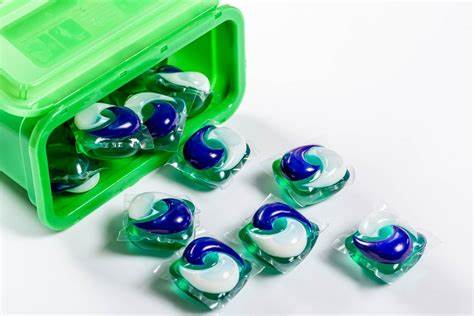Unpacking the Debate on Biodegradability and Environmental Impact
Introduction:
Polyvinyl alcohol (PVA) is a water-soluble plastic used to encase detergent pods, becoming a contentious topic in recent times. This blog post explores the ongoing debate regarding [PVA in detergent pods], shedding light on what these pods are, how they are used, and why the issue of PVA’s biodegradability has sparked controversy.
What Are PVA in Detergent Pods?
PVA detergent pods are small capsules containing concentrated laundry or dishwasher detergents. Encased in a water-soluble shell made of PVA, these pods are designed to be tossed directly into the washing machine or dishwasher. When the machine turns on, the outer casing dissolves, freeing the soap within, and the PVA goes down the drain. While convenient and mess-free, concerns have been raised about what happens to the PVA after dissolution.

Health and Safety Concerns:
Companies like Blueland and groups like the Plastic Pollution Coalition have petitioned the EPA to reconsider the safety rating of PVA. They argue that, despite dissolving in water, wastewater treatment doesn’t completely degrade it, leaving the potential for PVA to persist in oceans, waterways, and soil.
The Controversy over Biodegradability:
The core of the debate lies in the biodegradability of PVA. Research suggests that PVA may evade wastewater treatment, leading to significant concerns about its environmental impact. This claim has faced criticism from the chemical industry and environmental scientists, resulting in a divisive and ongoing dispute. The complexity of PVA degradation in different conditions further fuels the controversy.
Biodegradability is still a contentious area. Certification for biodegradability is granted if a product meets certain standards for decomposition under specific conditions. One of the leading manufacturers of PVA, KURARAY, has explicitly stated ‘Good biodegradation according to ISO14851.’ (Link) While this ensures some degree of biodegradation under the conditions specified by ISO14581, the reality is that when dissolved in water and exposed to the myriad conditions found in nature, these certifications may become invalid.

Scientific Studies:
Studies by Charles Rolsky and Varun Kelkar at Arizona State University indicate that 7,000 metric tons of PVA evade degradation in the US annually. They estimate that 4% of PVA from detergent pods ends up undigested, while 65% is disposed of in landfills or incinerated.
(Int. J. Environ. Res. Public Health 10, DOI: 3390.18116027/ijerph75)
Counterarguments from Industry:
However, the claims about PVA’s environmental impact have faced criticism from both the chemical industry and other environmental scientists. Executives at PVA maker MonoSol argue that the amount of PVA entering U.S. wastewater systems is greatly overestimated. Additionally, the American Cleaning Institute (ACI), which represents soap and detergent manufacturers, accuses the petition to the EPA as part of a marketing campaign. The ACI cites recent studies that concluded that the grade of PVA used in laundry detergent packs underwent extensive biodegradation in tests following international standard protocols. Ramani Narayan, a polymer researcher at Michigan State University, suggests that microorganisms can break down PVA used in pod films, but emphasizes that localized studies are required.
Potential Environmental Impact:
The potential environmental impact of PVA is still a matter of debate. The material may absorb pesticides and heavy metals and can act as a foaming agent, potentially harming aquatic ecosystems. Critics argue that localized hot spots of PVA should be studied for any adverse effects during its transient aquatic lifetime. Proponents like Judith Enck, president of Beyond Plastics, emphasize that the EPA should take the matter seriously. The biodegradability certifications may not take into account the multitude of real-world conditions that could invalidate the guarantees of PVA breakdown. The implications of PVA persistence in the environment demand closer scrutiny, given its potential to mobilize toxics like metals, pesticides, and flame retardants from sediments to waters.
Conclusion:
The issue of [PVA in detergent pods] presents a complex and polarizing subject. With conflicting opinions, studies, and interests at play, the controversy over its safety and environmental impact continues to evolve. The debate underscores the need for transparent scientific exploration and responsible regulation to protect both consumers and the environment.


